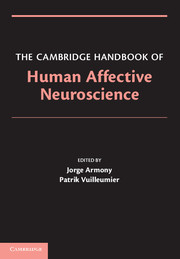Book contents
- The Cambridge Handbook of Human Affective Neuroscience
- The Cambridge Handbook of Human Affective Neuroscience
- Copyright page
- Dedication
- Contents
- List of Contributors
- Introduction
- Section I Introduction to Human Affective Neuroscience
- Section II Measuring Emotional Responses
- Chapter 2 Objective and Subjective Measurements in Affective Science
- Chapter 3 A Two-Way Road
- Chapter 4 Electro- and Magneto-Encephalography in the Study of Emotion
- Chapter 5 PET and fMRI
- Chapter 6 Lesion Studies in Affective Neuroscience
- Section III Emotion Perception and Elicitation
- Section IV Cognitive-Emotion Interactions
- Section V Emotional Learning and Memory
- Section VI Social Emotions
- Section VII Individual Differences in Emotion
- Index
Chapter 6 - Lesion Studies in Affective Neuroscience
from Section II - Measuring Emotional Responses
Published online by Cambridge University Press: 05 February 2013
- The Cambridge Handbook of Human Affective Neuroscience
- The Cambridge Handbook of Human Affective Neuroscience
- Copyright page
- Dedication
- Contents
- List of Contributors
- Introduction
- Section I Introduction to Human Affective Neuroscience
- Section II Measuring Emotional Responses
- Chapter 2 Objective and Subjective Measurements in Affective Science
- Chapter 3 A Two-Way Road
- Chapter 4 Electro- and Magneto-Encephalography in the Study of Emotion
- Chapter 5 PET and fMRI
- Chapter 6 Lesion Studies in Affective Neuroscience
- Section III Emotion Perception and Elicitation
- Section IV Cognitive-Emotion Interactions
- Section V Emotional Learning and Memory
- Section VI Social Emotions
- Section VII Individual Differences in Emotion
- Index
Summary
Keywords
- Type
- Chapter
- Information
- The Cambridge Handbook of Human Affective Neuroscience , pp. 154 - 168Publisher: Cambridge University PressPrint publication year: 2013



